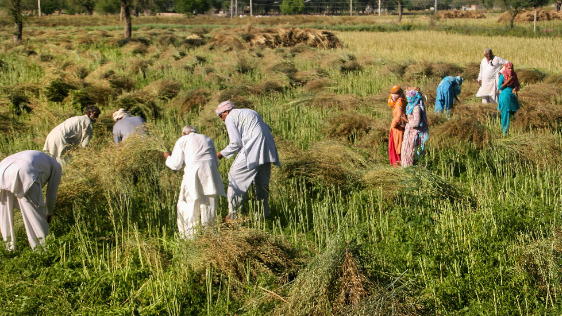Home truth
A genuine calculation would reveal that farm incomes — contrary to the popular belief — have declined over the past seven years; writes Shambhu Ghatak

In popular imagination, the rise in food production is often confused with the income and prosperity of farmers.
The quarterly data on GDP and GVA do not shed much light on the incomes earned by the farmers. The most reliable estimate on agricultural household incomes (and not the average income of a farmer in a particular time period) is produced by the National Statistical Office.
However, agricultural researchers, social scientists and economists had to wait for almost seven years this time to get the latest National Sample Survey (NSS) 77th Round data. The Situation Assessment Survey of Agricultural Households and Land and Livestock Holdings of Households in Rural India, was released recently.
It informs one about farm households' income in the crop year 2018-19 and indebtedness in 2019, among other things.
Change in nominal farm incomes
Let us try to understand the changes that happened to the incomes of farm households between crop years 2012-13 and 2018-19.
It needs to be mentioned at the outset that in the 77th Round of NSS, a farm household was defined as a household receiving value of produce more than Rs 4,000 from agricultural activities.
These activities included cultivation of field crops, horticultural crops, fodder crops, plantation, animal husbandry, poultry, fishery, piggery, bee-keeping, vermiculture, sericulture, etc.
The other criterion was that such a household must have at least one member self-employed in agriculture, either in the principal status or in subsidiary status during the last 365 days.
Households that were entirely agricultural labour households, and households receiving income entirely from coastal fishing, activity of rural artisans and agricultural services, were not considered as farm households.
However, in the 70th Round of NSS, a farm household was defined as a household receiving value of produce more than Rs 3,000 from agricultural activities.
The average monthly income of a farm household (when only the paid-out expenditure is considered) was Rs 10,218 during crop year 2018-19.
It was arrived at by adding together various constituents — including income from wages (Rs 4,063), income from leasing out of land (Rs 134), net receipt from crop production (Rs 3,798), net receipt from animal farming (Rs 1,582) and net receipt from non-farm business (Rs 641).
The average farm income (Rs 6,427) of an agricultural household (when only the paid-out expenditure is considered) during crop year 2012-13 was computed by totalling various components.
These included income from wages (Rs 2,071), net receipt from cultivation / crop production, when only the paid-out expenditure is considered (Rs 3,081), net receipt from farming of animals (Rs 763) and net receipt from non-farm business (Rs 512).
The NSS 77th Round report clearly mentions that the 'income of agricultural households from leasing out of land' was not collected in the previous rounds of the SAS.
However, in most media reports, this fact was ignored. They compared the average farm income of an agricultural household between crop years 2012-13 and 2018-19.
They subsequently concluded that the average monthly farm incomes grew by almost 59 per cent between those two crop years.
On deducting the 'income from leasing out of land', the modified average monthly farm income turns out to be Rs 10,084 in crop year 2018-19 — up from Rs 6,427 in 2012-13.
Change in real farm incomes
The average 'Consumer Price Index — Combined' grew by almost 34 per cent between crop years 2012-13 and 2018-19.
If we take that into account, then the growth in the average monthly income per farm household (considering only the paid-out expenditure) in real terms during this time period was 22.9 per cent in India.
The average 'CPI-Rural' increased by around 35.3 per cent between the crop years 2012-13 and 2018-19.
If we take that into consideration, then the growth in the average monthly income per agricultural household (considering only the paid-out expenditure) in real terms during this time period was 21.6 per cent at the national level.
Seeing this, many would conclude that everything is well and fine with the farming community.
It should be kept in mind that the average monthly income per farm household (considering only the paid-out expenditure) is not the same as 'net income / receipt earned by a farm household from crop cultivation' — the latter is just one of the components of the former.
If the rate of inflation of 34 per cent between the crop years 2012-13 and 2018-19 is taken into account, then the growth in the average monthly 'net receipt from crop production or cultivation' per farm household in real terms during this time period was -10.7 per cent in India.
If the rate of inflation of 35.3 per cent between the crop years 2012-13 and 2018-19 (in average 'CPI - Rural') is taken into consideration, then the growth in the average monthly 'net receipt from crop production or cultivation' per farm household in real terms during this time period was -12.0 per cent in India.
Reference period
For the NSS 77th Round, information was collected primarily for the agricultural year 2018-19 in two visits — visit-1 and visit-2.
For crops, information on expenses and receipts from cultivation were collected for the period July to December 2018 during visit-1 and for January to June 2019 during visit-2.
However, it was ensured that all the crops harvested during agricultural year 2018-19 were duly considered in either visit-1 or visit-2.
The same reference period was used for collecting information on productive assets. For other items of information, different reference periods were used.
For information on land possession, productive assets and expenses and receipts from cultivation, earnings from wages / salaried employment, earnings from pension / remittances the reference period was July to December 2018 in visit-1 and January to June 2019 in visit-2. DTE
Views expressed are personal



